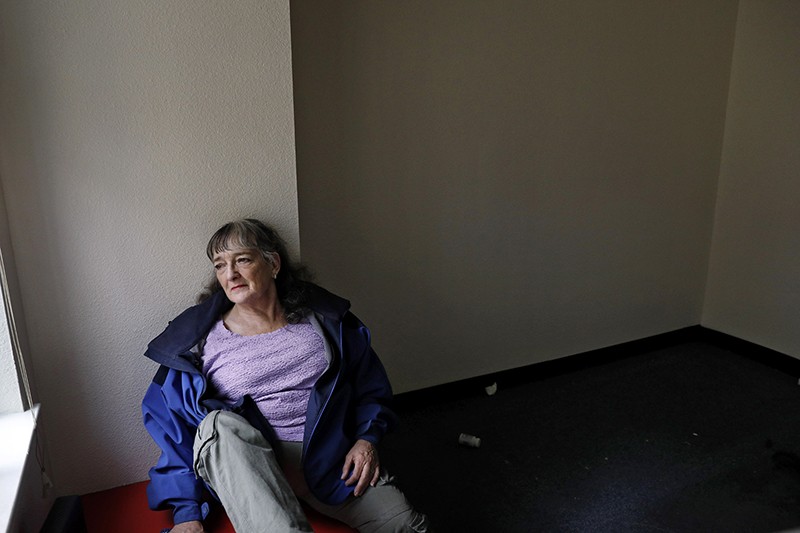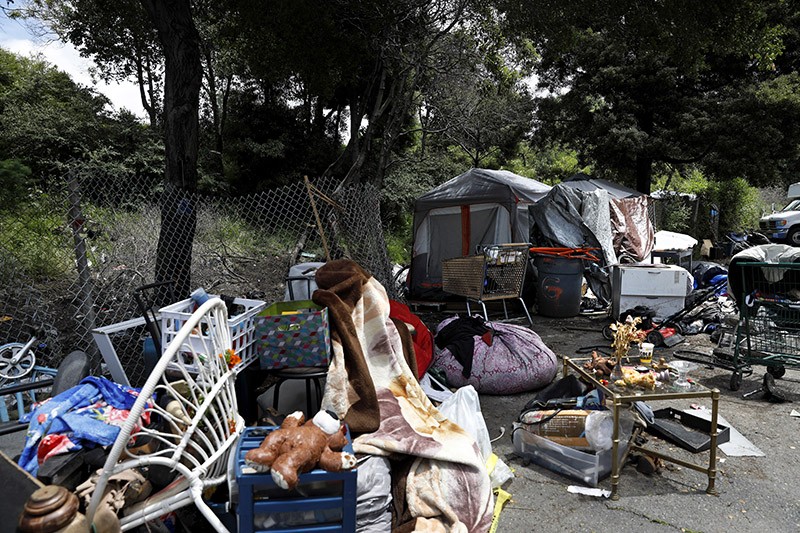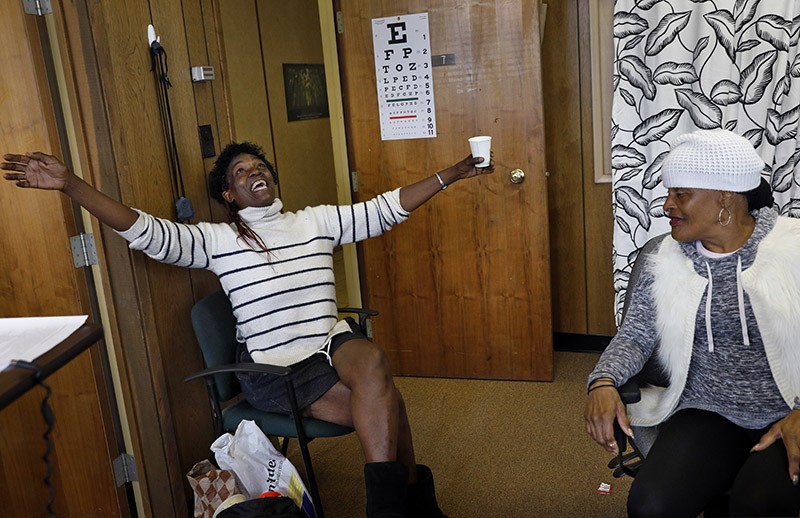21 MAY 2019
Understanding why living on the street seems to cause rapid aging could help homeless people — and governments.

Maria Haverstock, a participant in the Oakland study, became homeless at 58 when she could not find work after leaving an abusive partner. Credit: Preston Gannaway for Nature
When Serggio Lanata moved to San Francisco in 2013, he was stunned by its sprawling tent cities. “Homelessness was everywhere I looked,” he says. Lanata, a neurologist at the University of California, San Francisco (UCSF), was also struck by similarities in the behaviour of some older homeless people and patients he had treated for dementia in the clinic. Now, years later, he is embarking on a study that will examine homeless adults for early signs of Alzheimer’s disease and other degenerative brain disorders to better understand the interplay between these conditions and life on the street.
The work, which is set to begin next month, ties into an ongoing effort by researchers at UCSF to understand the biological effects of homelessness in older people. Since 2013, a team led by Margot Kushel, director of the university’s Center for Vulnerable Populations, has followed a group of about 350 older homeless adults in Oakland, California, to determine why this group ages in hyper-speed. Although the participants’ average age is 57, they experience strokes, falls, visual impairment and urinary incontinence at rates typical of US residents in their late 70s and 80s.
The research has drawn attention from politicians, economists and health-care providers across the country who are struggling to help the homeless and reduce their numbers. Although homelessness is a global problem, the situation in California is particularly acute. Nearly 70% of the 130,000 people without homes in the state are considered to be ‘unsheltered’, living on the streets or in locations unfit for human habitation, compared with just 5% in New York City. In the San Francisco Bay Area — California’s wealthy technology hub, which includes Silicon Valley — roughly 28,200 people are homeless.
 Homeless encampments, like this one in Oakland, California, are a familiar site in the San Francisco Bay Area. Credit: Preston Gannaway for Nature
Homeless encampments, like this one in Oakland, California, are a familiar site in the San Francisco Bay Area. Credit: Preston Gannaway for Nature
The United States’ homeless population is also greying: rising housing prices in many areas have increased the rate of homelessness among ‘baby boomers’ born between 1954 and 1964. But many hospitals, police and homeless shelters are unprepared to deal with the special needs of an ageing homeless population. “I hear from shelter providers, ‘Gosh, we are set up for people who use drugs but we have no idea how to manage dementia’,” Kushel says. By understanding how homelessness can accelerate ageing, her team hopes to identify ways to curb suffering and save governments money.
“This crisis is upon us,” says Dennis Culhane, a social scientist at the University of Pennsylvania in Philadelphia. “A lot of money will be spent on this population. We can draw upon Margot’s data and learn how to spend that money wisely — or else we’ll just spend and still have lots of human misery.”
He and his colleagues estimate that Los Angeles, California, will spend $621 million annually on emergency medical care, nursing home beds and shelters for homeless people over the age of 55 between 2019 and 2030. Their analysis suggests that the city could reduce its spending by $33 million per year if it provided homes to elderly people who lack them.
A closer look
Researchers have known for decades that physical and mental health problems are prevalent among the homeless (see 'Declining health'). But there was little systematic research on the progression and causes of their ailments in 2013, when Kushel launched a study on the life trajectories of older homeless adults in the Bay Area. Since then, 42 of the initial 350 participants have died — mainly from cancer, heart attacks and diabetes. (Earlier this year, the study enrolled another 100 people to compensate for the loss of original participants.)
Kushel and her colleagues got a boost on 1 May, when philanthropists Marc and Lynne Benioff announced that they had donated US$30 million to create a research initiative at UCSF on homelessness. Marc Benioff, who founded the San Francisco-based computing company Salesforce, says the money will support research to explore the causes of homelessness and identify ways to prevent it.
Lanata’s study, which is set to begin next month, will look for signs of debilitating brain conditions — such as dementia of the frontal and temporal lobes, which can cause behavioural changes — in at least 20 homeless adults. He and his colleagues will conduct neurological exams, which might include brain scans, on participants to learn how homelessness influences these brain disorders. People living on the streets might face several factors that can contribute to neurological disease, Lanata says, such as lack of sleep, exposure to polluted air near highways, poorly controlled diabetes, high blood pressure and alcohol abuse.
By asking study participants about their personal histories, he also hopes to learn whether neurological issues might have helped to put them on the street — perhaps by impairing their ability to work or seek government assistance. That would make sense to him, given his experience treating people with some types of dementia. “If those patients didn’t have strong family support, they would be homeless, since no one could or would care for them,” Lanata says. “They can be hard to handle.”
And Kushel has begun a new phase of her ongoing study, which will explore how the sudden stress of homelessness might trigger or exacerbate existing conditions. Many of the people in her study were over the age of 50 when they became homeless.
 Kimberly Lea (left) greets Vernada Jones, who is recovering from a gunshot wound to the face. Both women are participating in the Oakland study. Credit: Preston Gannaway for Nature
Kimberly Lea (left) greets Vernada Jones, who is recovering from a gunshot wound to the face. Both women are participating in the Oakland study. Credit: Preston Gannaway for Nature
Nearly half of the participants exhibit signs of extreme loneliness, which has been linked to poor outcomes in people with cancer and other diseases1. One-quarter of those in the study meet the criteria for cognitive impairment, compared with less than 10% among people over the age of 70 in the United States more generally2. And in a paper in the press, Kushel and her colleagues found that 10% of participants report being physically or sexually assaulted at least every six months.
An increasing toll
Although Culhane and other health economists have already begun to use Kushel’s findings to project how much it costs to care for the indigent, it is not clear whether politicians or the public will accept such suggestions.
California Governor Gavin Newsom included $500 million for shelters and other support facilities in his proposed $209 billion state budget for 2019–20. But in late March, San Francisco residents rapidly met their goal of raising more than $100,000 to block the construction of a homeless shelter in a wealthy, waterfront neighbourhood. And although city voters approved a plan in November 2018 to fund services for the homeless by taxing the San Francisco’s biggest companies, business groups are challenging the policy in court.
Coco Auerswald, a public-health researcher at the University of California, Berkeley, hopes that Kushel’s work and other studies of homelessness strike a moral nerve. “You judge a society on how it treats its most vulnerable,” she says. “My fear is that we will accept this as a state of affairs in our country.”
Nature 569, 467-468 (2019)
doi: 10.1038/d41586-019-01573-0












Đăng nhận xét